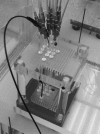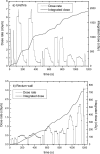A phantom study of an in vivo dosimetry system using plastic scintillation detectors for real-time verification of 192Ir HDR brachytherapy
- PMID: 21776789
- PMCID: PMC3104721
- DOI: 10.1118/1.3572229
A phantom study of an in vivo dosimetry system using plastic scintillation detectors for real-time verification of 192Ir HDR brachytherapy
Abstract
Purpose: The goal of the present work was to evaluate the accuracy of a plastic scintillation detector (PSD) system to perform in-phantom dosimetry during 192Ir high dose rate (HDR) brachytherapy treatments.
Methods: A PSD system capable of stem effect removal was built. A red-green-blue photodiode connected to a dual-channel electrometer was used to detect the scintillation light emitted from a green scintillation component and transmitted along a plastic optical fiber. A clinically relevant prostate treatment plan was built using the HDR brachytherapy treatment planning system. An in-house fabricated template was used for accurate positioning of the catheters, and treatment delivery was performed in a water phantom. Eleven catheters were inserted and used for dose delivery from 192Ir radioactive source, while two others were used to mimic dosimetry at the rectum wall and in the urethra using a PSD. The measured dose and dose rate data were compared to the expected values from the planning system. The importance of removing stem effects from in vivo dosimetry using a PSD during 192Ir HDR brachytherapy treatments was assessed. Applications for dwell position error detection and temporal verification of the treatment delivery were also investigated.
Results: In-phantom dosimetry measurements of the treatment plan led to a ratio to the expected dose of 1.003 +/- 0.004 with the PSD at different positions in the urethra and 1.043 +/- 0.003 with the PSD inserted in the rectum. Verification for the urethra of dose delivered within each catheter and at specific dwell positions led to average measured to expected ratios of 1.015 +/- 0.019 and 1.014 +/- 0.020, respectively. These values at the rectum wall were 1.059 +/- 0.045 within each catheter and 1.025 +/- 0.028 for specific dwell positions. The ability to detect positioning errors of the source depended of the tolerance on the difference to the expected value. A 5-mm displacement of the source was detected by the PSD system from 78% to 100% of the time depending on the acceptable range value. The implementation of a stem effect removal technique was shown to be necessary, particularly when calculating doses at specific dwell positions, and allowed decreasing the number of false-error detections-the detection of an error when it should not be the case--from 19 to 1 for a 5% threshold out of 43 measurements. The use of the PSD system to perform temporal verification of elapsed time by the source in each catheter--generally on the order of minutes--was shown to be in agreement within a couple of seconds with the treatment plan
Conclusions: We showed that the PSD system used in this study, which was capable of stem effect removal, can perform accurate dosimetry during 192Ir HDR brachytherapy treatment in a water phantom. The system presented here shows some clear advantages over previously proposed dosimetry systems for HDR brachytherapy, and it has the potential for various online verifications of treatment delivery quality.
Figures









Similar articles
-
Technical note: removing the stem effect when performing Ir-192 HDR brachytherapy in vivo dosimetry using plastic scintillation detectors: a relevant and necessary step.Med Phys. 2011 Apr;38(4):2176-9. doi: 10.1118/1.3562902. Med Phys. 2011. PMID: 21626951 Free PMC article.
-
On the use of a single-fiber multipoint plastic scintillation detector for 192Ir high-dose-rate brachytherapy.Med Phys. 2013 Jun;40(6):062101. doi: 10.1118/1.4803510. Med Phys. 2013. PMID: 23718599 Free PMC article.
-
The evaluation of a 2D diode array in "magic phantom" for use in high dose rate brachytherapy pretreatment quality assurance.Med Phys. 2015 Feb;42(2):663-673. doi: 10.1118/1.4905233. Med Phys. 2015. PMID: 28102606
-
Comparative Analysis of 60Co and 192Ir Sources in High Dose Rate Brachytherapy for Cervical Cancer.Cancers (Basel). 2022 Sep 29;14(19):4749. doi: 10.3390/cancers14194749. Cancers (Basel). 2022. PMID: 36230672 Free PMC article. Review.
-
The clinical application of in vivo dosimetry for gynaecological brachytherapy: A scoping review.Tech Innov Patient Support Radiat Oncol. 2024 Nov 16;33:100290. doi: 10.1016/j.tipsro.2024.100290. eCollection 2025 Mar. Tech Innov Patient Support Radiat Oncol. 2024. PMID: 39802319 Free PMC article. Review.
Cited by
-
Polyethylene Naphthalate Scintillator: A Novel Detector for the Dosimetry of Radioactive Ophthalmic Applicators.Ocul Oncol Pathol. 2015 Sep;2(1):5-12. doi: 10.1159/000381720. Epub 2015 Jun 6. Ocul Oncol Pathol. 2015. PMID: 27171681 Free PMC article.
-
A review of recent advances in optical fibre sensors for in vivo dosimetry during radiotherapy.Br J Radiol. 2015 Jun;88(1050):20140702. doi: 10.1259/bjr.20140702. Epub 2015 Mar 11. Br J Radiol. 2015. PMID: 25761212 Free PMC article. Review.
-
In Vivo Verification of Treatment Source Dwell Times in Brachytherapy of Postoperative Endometrial Carcinoma: A Feasibility Study.J Pers Med. 2022 May 31;12(6):911. doi: 10.3390/jpm12060911. J Pers Med. 2022. PMID: 35743696 Free PMC article.
-
On the nature of the light produced within PMMA optical light guides in scintillation fiber-optic dosimetry.Phys Med Biol. 2013 Apr 7;58(7):2073-84. doi: 10.1088/0031-9155/58/7/2073. Epub 2013 Mar 8. Phys Med Biol. 2013. PMID: 23470253 Free PMC article.
-
In vivo dosimetry: trends and prospects for brachytherapy.Br J Radiol. 2014 Sep;87(1041):20140206. doi: 10.1259/bjr.20140206. Epub 2014 Jul 8. Br J Radiol. 2014. PMID: 25007037 Free PMC article. Review.
References
Publication types
MeSH terms
Substances
Grants and funding
LinkOut - more resources
Full Text Sources

